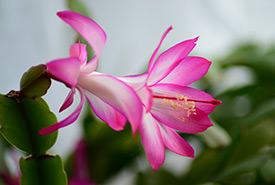De-stressing with plants

McHugh Lake Loop, MB (Photo by Wikimedia Commons)
During the pandemic, many people experienced increased stress levels due to illness, work difficulties and isolation. But many of us have discovered that there is solace in the natural world. In 1984, biologist E.O. Wilson noted that “biophilia,” or a “love of nature,” is a normal part of human psychology. We don’t just love nature; we need it for optimal health. A growing body of research has found that spending time outdoors, bringing nature indoors, and even experiencing it virtually, improves health. It reduces chronic stress and accelerates healing. Even now, as the last days of winter linger on, there are ways that we can de-stress by enjoying nature.
Related content
Spend time outside
Visiting a local park or natural area can improve your mood and boost immunity. Urban parks, such as Assiniboine Forest and Living Prairie Museum in Winnipeg, are easy to get to by car or bus. If you can travel further in Manitoba, skiing, snowshoeing and winter hiking are ways to enjoy the province’s forests and Prairies. And even though part of our world is covered in snow, some plants can still be identified. Evergreen trees and shrubs retain their cones and don’t lose their leaves. Even deciduous woody plants can be identified by closely examining the leaf scars (places where leaves grew) on the stems. Relaxing post-hike activities might include sketching or painting (take pictures to help you remember what you saw) and writing about your experience in a nature journal.
Bring nature indoors

House plants, like this Christmas cactus, provide many benefits. (Photo by Pixabay)
Growing houseplants is a great way to beautify your home and create a Zen-like space to relax in. In addition to their beauty, houseplants are known to remove organic air pollutants, like benzene and formaldehyde, released from carpeting and furniture.
Before getting any houseplants, assess your home’s light and humidity conditions. Note especially what direction your windows are facing. North- or east-facing windows are suitable for plants that need low or filtered light, such as Christmas cactus or weeping fig trees. West- or south-facing windows are good for succulents like aloe and burro’s tail. Some tropical plants, like staghorn ferns, need to be placed near a humidifier or misted regularly to do well.
Remember to buy only greenhouse-grown plants, not plants poached from the wild, as this behaviour is causing the endangerment of rare species, like orchids and cacti. Raising cuttings from your friends’ houseplants or participating in plant swaps are great ways to grow your collection sustainably, and it can save you lots of money, too!
Enjoy virtual nature

An ever-changing wall projection in the new Prairies Gallery depicts the four seasons. (©Manitoba Museum/Ian McCausland)
Even virtual nature has psychological benefits. Viewing paintings of natural landscapes, nature documentaries and virtual reality programs can induce feelings of peacefulness similar to being outside. For a more three-dimensional experience, consider a stroll through the Manitoba Museum’s galleries, where time is frozen in life-like dioramas that depict some of Manitoba’s most beautiful landscapes. The new Prairies Gallery also features a realistic wall projection depicting the four seasons on a pristine grassland.
Learn more about wild plants
Greater health benefits can be achieved by connecting with nature more deeply and using multiple senses. What do the plants feel like? Are the leaves smooth or covered with fuzzy or stiff hairs? What do they smell like? What sorts of animals interact with them? You can learn more about the characteristics of wild plants by studying field guides or checking out websites such as iNaturalist or the Manitoba Museum’s Prairie Pollination virtual exhibit. When you are ready to go hiking again, you’ll know which species you’re seeing and which are safe to touch.
Taking the time to disconnect from our gadgets, and reconnect with the natural world, can be a highly beneficial addition to our self-care routines.
This post originally appeared on the Manitoba Museum blog.


